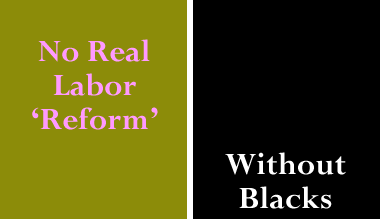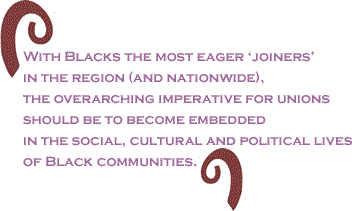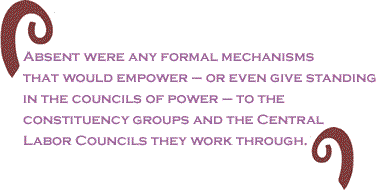
|
|||||||||||||||||||||
 |
Far from ameliorating the crisis afflicting what’s left of organized labor in the United States, a number of “reforms” proposed by some of the nation’s largest unions appear as attempted rollbacks of historic gains won by Blacks, Latinos and women unionists a decade ago. Simply put, the vast changes in AFL-CIO structures demanded by the giant (and heavily minority) Service Employees International Union (SEIU), the Teamsters and others, contain no formal mechanisms to ensure that core labor constituencies have a voice remotely commensurate with their numbers and strategic importance. The “reformers” demands dominated this week’s just concluded winter meeting of the labor federation’s Executive Council, in Las Vegas, a “fierce” series of discussions in which SEIU chief Andy Stern and his allies called for “streamlining” the AFL-CIO by paring down the number of unions from 58 to 20, drastically shrinking the size of the Executive Council, implicitly reducing the role of state and local labor bodies and, most disastrous for Black unionists, eliminating constituent group representatives on the Executive Committee. “If the ten largest unions will comprise the Executive Committee, no Black that I’m aware of, or woman that I’m aware of, heads up a union of that size,” said William Lucy, President of the 33-year-old Coalition of Black Trade Unionists (CBTU). “How does our voice get in that decision making process? How do we talk about the value of organizing as a community empowerment process? Who do we discuss that with?” The SEIU and Teamsters proposals include nothing resembling formal institutional representation for Blacks, Latinos, other minorities and women – groups that comprise nearly three out of five unionized workers. It was specifically to include underrepresented groups that the AFL-CIO expanded its Executive Council from 35 to 54 seats in 1995, when John Sweeney was elected president. A decade later, “reformers” place part of the blame for labor’s ongoing decline on the size of the Council, and would centralize power in the hands of consolidated union chiefs.
The inevitable perception is that Stern, Hoffa & Co. believe that the institutional inclusion of minority and female voices on the Council is at least partially to blame for labor’s woes. Or is it a case of the key constituents getting thrown out with the Executive Council bathwater? The CBTU’s William Lucy would like to know, but he’s not getting answers. “Given the fact that we’ve got millions of workers to organize, how will our concerns be put on the table? How will our views be shared in terms of our politicization and organizing in our communities?” asked Lucy, who estimates that close to 30 percent of organized labor is Black. Black Power = Union Power There was a time when union halls in many cities were centers of community activity, inseparable from the social, cultural and political life of the surrounding neighborhoods. Vital, active local union halls were the pride of organized labor – but that was back when white union members both lived and worked in the cities. Now that the cities and union membership are largely Black and brown, Blacks are confronted with demands for greater centralization of resources, authority, and planning in the hands of white-dominated headquarters leadership. Lucy thinks the “reformers” have it backwards: “Ultimately, our argument is that the Central Labor Councils and state federations are the voice and face of organized labor in the urban community, and therefore they must be made more effective in articulating labor’s program, projects and agenda.” In order to free labor from its hard-hat white racist image in the Black community – a stereotype that segments of labor earned, to the movement’s great shame and detriment – local labor activists and leaders must be perceived as community members who are empowered to bring labor’s clout to bear on behalf of the community. Such relationships cannot be forged from a distance, or shoe-horned into the local manifestation of a national headquarters mandated campaign – certainly, they cannot be switched on and off based on the needs of national strategists.
Let us be clear: Local Black unionists require a degree of autonomy and discretionary resources so that they may demonstrate both their desire and capability to respond to immediate community concerns – that is, to serve and enhance the political power of the people. As the most consistently progressive ethnic group in the United States, the Black community’s empowerment redounds directly to the benefit of labor. Historically, however, Big Labor has failed to act decisively on this obvious equation. It appears the past is about to be repeated. The South and the South Side Labor defended its failure to organize the
South – a project that
would of necessity have required massive involvement in the southern
Black freedom struggle – on the grounds that massive white public
and private resistance to unionization of Dixie made the task prohibitively
expensive. The chickens that hatched from this historic blunder – rooted
in racism, not accounting – have long since come home to roost.
Any honest analysis of labor’s decline since the heyday of the
Fifties would conclude that the successful maintenance of a racist,
anti-labor southern sanctuary created an inherent bargaining weakness
for workers, nationwide. Indeed, we at What have they learned? A number of unions now invest in southern organizing, the SEIU quite notable among them. However, with Blacks the most eager “joiners” in the region (and nationwide), the overarching imperative for unions should be to become embedded in the social, cultural and political lives of Black communities – to achieve political density in order to gain union membership density. Constituent organizations like the Coalition of Black Trade Unionists are indispensable to this task, yet they are shut out of the “reformer’s” proposed Grand Plan. We are witnessing the unfolding of another historic blunder – this time, possibly fatal.
Similarly, a great battle looms over the shape and governance of the cities, a struggle that must politically organize Black and Latino communities to make the cities into bulwarks of social democracy, an environment in which unionism can thrive. Yet at just this juncture, the “reformers” propose to neuter the constituent groups that represent these populations, who would provide the political leadership to transform urban America. Little more than lip service is paid to the role of Central Labor Councils, the structures through which urban unionists operate. “The labor councils aren’t represented at the Executive Council. Their issues will be interpreted by somebody else,” said Pat Ford, a former executive vice president of SEIU, now assistant for civic affairs to the president of the AFL-CIO Metropolitan Washington DC Central Labor Council. “We applaud John Sweeney’s efforts [at this week’s Las Vegas meeting], his asking for input from state labor councils and the constituencies. But we need to be at the table, not someone else interpreting our position.” If Black unionists are not demonstrably respected in the House of Labor, they will not be viewed as functioning representatives of labor on the streets of America’s cities. Labor will lose a credible “face and voice” and, once again, weaken itself. “I don’t think there is any malice in any of these international presidents, or any intentional disrespect,” said Ford. “I don’t think they understand the reason for our passion about this.” ‘We know best. Trust us.’ The 34 months of John Kennedy’s presidency (January 1961 – November 1963) were often quite frustrating to Blacks. The Kennedy brothers, John and Bobby, offered African Americans words of solidarity, but hedged and hesitated when it came to putting those sentiments into legislative form. Trust us, they seemed to say, we’re on your side, we’ll do the right thing from our executive posts. But it was left to President Lyndon Johnson to pass the laws that truly transformed the lives of African Americans, by creating real mechanisms for Black empowerment. We were reminded of this period when a letter/article arrived
from Gerald Hudson, the current Black executive vice president
of SEIU, in response to our February
3, 2005 critique of the proposed “reforms” titled, “Black Unionists
Warn: Don’t ‘Restructure Us Out.” Hudson’s message was gracious
(see “The SEIU responds to a
The veteran union activist and executive presented his personal (sterling) bona fides, then proceeded to cover the same points outlined in Andrew Stern’s Unite to Win document: a critique of the current “balkanized structure” that “often keeps workers from developing strategies that match the corporations they deal with”; a general plan that would strengthen “the role of local labor councils” by causing them to “develop and be held accountable to a strategic plan for building community alliances and coordinating political action to support national strategies to build workers’ strength in each industry”; and “clear standards” – actually, anything but clear – to establish “full participation at all levels of the union movement regardless of the color of your skin, the language that you speak, or your age, gender, ethnicity, sexual orientation, disability, or immigration status.” Absent from these general statements of intent, headquarters mandates, and the requisite diversity statement, were any formal mechanisms that would empower – or even give standing in the councils of power – to the constituency groups and the Central Labor Councils they work through. Hudson then points to his union’s executive board that “is 40 percent female and 33 percent people of color” – a statistic that is irrelevant to the monumental matter at hand: a full restructuring of the national labor movement. What Hudson and Stern and other “reformers” are actually saying to Blacks is: Trust us. We’ll do the right thing on our own. The constituent groups don’t need formal status, resources, or a voice at the table. We’re on your side. Just like the Kennedy brothers, more than four decades ago. Such assurances are as unacceptable now, as they were then. It is particularly disturbing to hear union leaders, of all people, resist the formalization of processes and mechanisms through which constituents exercise effective influence – a contract, if you will. Absent a contract, all that remains is arbitrary use of power. Every good unionist knows that. A wall of silence on race History – including very recent history – dictates that
Blacks, most of all, need and deserve a contract with organized
labor. In few places outside of Black circles are the racial ramifications
of AFL-CIO restructuring seriously discussed – including most of
the position papers and articles promulgated by the vaguely defined
Left. One exception is a letter circulated by a group that includes
Bill Fletcher, President of TransAfrica, former SEIU executive
Pat Ford, AFRAM-SEIU National
President Marchel Smiley, and an impressive interracial list of
academic and activist colleagues.
In other words, Black and Brown Power equals Labor Power. However, it is impossible to envision organizing drives in minority areas reaching full potential when the constituent groups that reflect the comprehensive aspirations of these populations are institutionally shut out of the action – as they were in the 2004 election. While unions spent more $100 million dollars on Democrats – much of it outsourced to “527” organizations – constituent groups like the Coalition of Black Trade Unionists, which had submitted detailed plans for grassroots mobilization, were left out in an unfunded, arctic cold.
And that was under the current AFL-CIO leadership and structure, in which minorities are represented as union leaders on the expanded (since 1995) Executive Council and as constituent groups. The proposed “streamlining” portends an even deeper chill – a near-total freeze-out at the heights of labor decision making. “Constituency groups get very little money from international unions – they get it from the AFL-CIO,” said Pat Ford. “What happens to them when you cut the AFL-CIO budget by 50 percent, as the Teamsters are proposing.” Neither SEIU’s Unite to Win document nor
the Teamsters’ position
paper make a single reference to the unprecedented severity of
the union workplace massacres that African Americans are
subjected to in today’s labor market. “Fifty-five percent (or
168,000) of the union jobs lost in 2004 were held by black workers,” wrote
Dwight Kirk, in the February
24, 2005 issue of Andrew Stern and James Hoffa see a structural crisis in the AFL-CIO, but cannot seem to comprehend that the particular historical and current reality for Black workers requires – demands – that representatives of their choosing be systematically and institutionally heard and heeded in every venue of power. Not at the whim of top leadership, but through mechanisms (and financing) built into the structure. CBTU President William Lucy is compelled to engage in the repetition that is born of non-responsiveness by the other party. “We need to raise the question: How will minority influence be enhanced? What’s the specific mechanism?” To date, no credible answers have been forthcoming. Which means that union “reformers” are adding yet another layer to the deep crisis afflicting the most underdeveloped labor movement in the so-called “developed” world. Race has always been the nexus of labor’s failures in the United States. Today’s “reformers” may think they have a good reputation and bedside manner, but the medicine they are prescribing only worsens the ailment. “We are the most loyal segment of the trade union vote and the Democratic Party vote, yet our voices are not at the center of the discussion about the reforms that are necessary,” said Lucy. In Las Vegas this week AFL-CIO chief John Sweeny and the insurgents locked horns on every issue except those that matter most to the organized Black labor constituency. The Coalition of Black Trade Unionists holds its 34th annual International Convention in Phoenix, May 25-30, 2005 – as critical a gathering as any since the CBTU’s founding in 1972. Given the rollbacks of Black influence in labor that will be on the table at the AFL-CIO convention in Chicago, in July, the CBTU convention’s theme, “Forging a New Vision for Tough Challenges Ahead,” seems almost understated. |
| March 3 2005 Issue 128 |
|||||||||
|
|||||||||
|
|
|||||||||
| Printer Friendly Version | |||||||||
 |
|||||||||
 |
|||||||||
| |
|||||||||
| |
|||||||||





























